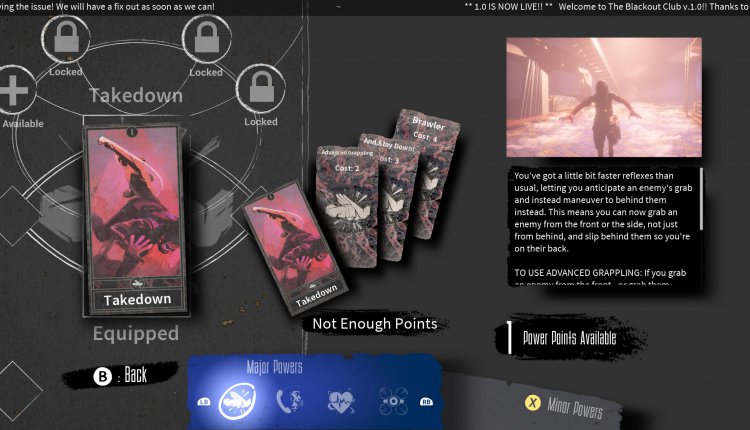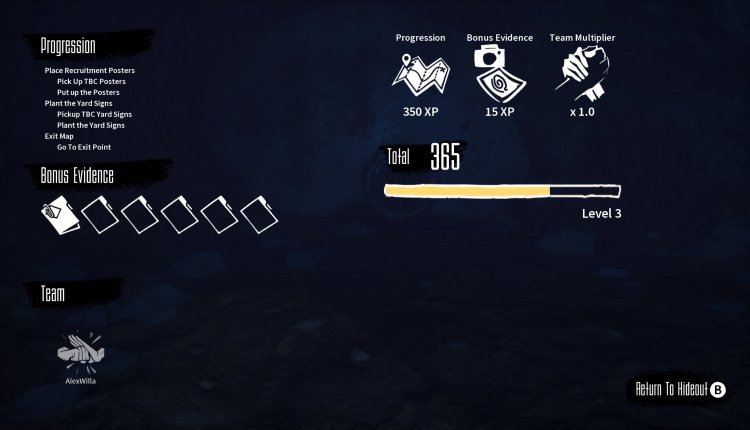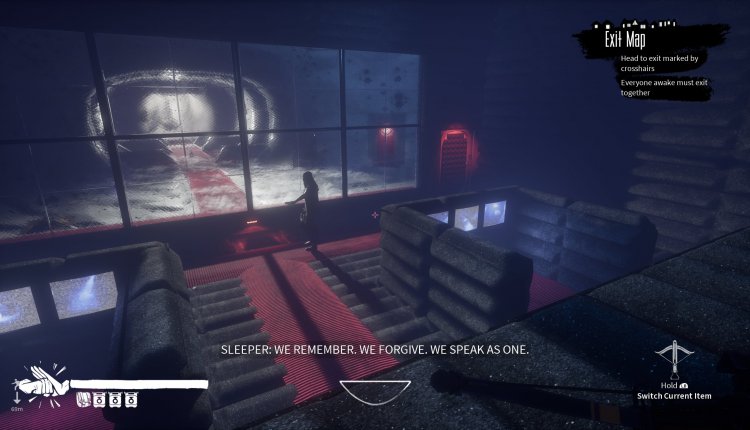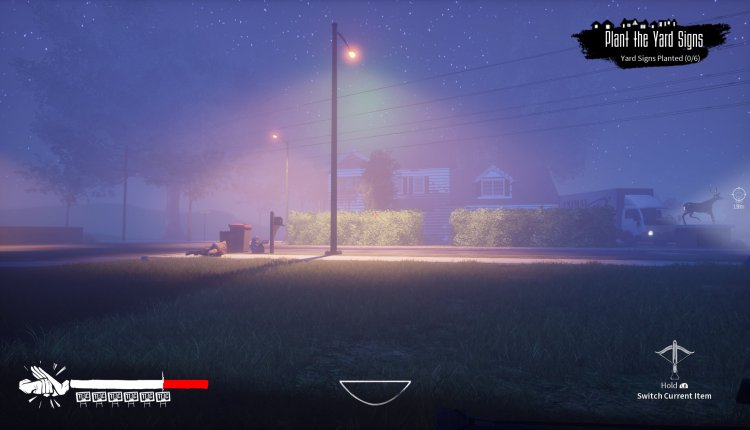The Blackout Club — Spare pants required
It’s coming… it’s relentless… and you’re powerless to stop it once it has your scent; worst of all you can’t see it. The Blackout Club from Question has you investigating the creepy, nocturnal events of the sleepy town where your friends are being abducted and something — or someone — plays a puppet master controlling the neighbourhood adults into doing its bidding. The parallels to the latest season (3) of Stranger Things are not lost on us.
The Blackout Club classes itself as multiplayer psychological horror, and that’s a great label for the game, indeed, it starts with one of the most effective hooks I’ve experienced in a while. The prologue begins as most do — laying out some of the basic mechanics — the members of the club in question contact you through your mobile phone, leading you through the first few minutes via a series of text messages.
Quickly it becomes quite clear something is afoot as it is incredibly dark and the house is empty. The Blackout Club members recommend closing your eyes to see the truth, a button press later and you are introduced to the first part of that hook; you can see things when you close your eyes. Directions, messages & pictures assist you to move the prologue script forward but whilst your eyes are shut you cant see the world around you, obstacles and all.
Immediately, after throwing this mechanic at you, the music turns more ominous and you find yourself being hunted by something called the Shape, you can’t see it in the real world and its only visible once you close your eyes. There’s no defense and your only option is to run or hide. Whilst hidden the music gets more intense the closer it gets, an invisible enemy intent on ending you. Avoiding it and escaping the house leaves you with no option but to progress alone to meet the rest of the Club knowing the Shape is out there, and that it’s always coming.
The game begins for real as soon as you find the Blackout Club’s train car hideout. Here you have the option to customise (albeit quite simply) your character. Once you have selected your avatar’s features, hair and clothes you have the option to select a primary weapon as well as invest in several useful perks to assist you in your mission. Although skill point investment is permanent you can always return here after a mission to change your loadout and equip other weapons or unlocked talents.

Each talent tree has several tiers requiring an increasing amount of invested points at each level to unlock or further improve each skill set. Five major talents are on offer; one bestows a drone for use and another gives you some increased offensive capability. Further investment allows your drone other capabilities such as a tranquilizer attachment or a camera but that requires points you won’t have immediately. A good mix of capabilities across your team definitely gives you an advantage and some objectives are made easier by certain skills. Alone however, its best to supplement your own play style.
You can also equip up to four minor powers which, once unlocked, bestow your character with additional items from the start of each mission rather than starting with only your selected one shot ability. Higher level character are much better equipped to progress although with that capability the game also increases the threat level to offer some balance.
As you complete missions offered by the Club, you level up via the experience earned on completion of the primary mission objectives and any secondary objectives offered in each mission. Playing with others is recommended as getting everybody out safe gives rewards to the players in the form of a team multiplier, quickening progress. Initially, to get through the first few character levels, there is some repetition as the same few missions are recycled. Once you hit a new level, however, a new set of objectives or missions are entered into that rotation, offering much more variation.
New areas previously locked or closed off are opened up expanding the playing field and gradually new enemies are introduced. As you progress even further new parts of town are opened up giving you even more options. Progression also comes in the form of Voices. These are the powers controlling the darkness or even fighting against it — it’s difficult to know if they are good or bad. Playing with the “Enhanced Horror” features on can offer some pretty unique gameplay experiences as the voices try to interact with you. An ‘Offering Ritual’ option at the end of missions allows you to also ask questions to the voices and the dreams you have let you listen into the rituals from other players across the region. You might get an answer to your questions and you may not. Not knowing is part of the fun.

Threats, after the prologue, start simple with only sleepwalking adults to contend with. They can’t see you but they can hear you when you are close. These subdued adults are attracted to footsteps and noise; breaking from their aimless meandering if you make too much noise. You can sneak whilst crouched to conceal yourself and decrease noise but careful selection of your route is paramount since different surfaces offer different sound levels. Carpets are quiet whilst tarmac isn’t, for example. A few items found in the field (or offered as minor powers); such as firecrackers; allow you to distract the Walkers, whilst foam cans deploy a bed of noise-absorbent goop designed to increase stealth, or hide the noise created when you drop from height.
Lucids are released onto the field shortly after. These offer a different challenge in an enemy who can actually see, albeit only in good light. The game offers a visibility scale through an eye in the middle of the bottom of the HUD. When the eye-icon shows as closed you are well hidden, however if fully open then you are exposed. It’s not a problem when there are only Walkers but a Lucid will hone straight in causing you to have to outrun or out-think it. Careful teams need to work together to spot enemies, recognize their type and evade or subdue as required.
Getting caught isn’t the end though. You have some defensive items available and you can also shove away the adults as the cost of some of your combined health and stamina bar. Once depleted you can’t run as far and you won’t be able to shove them away. Here you enter a downed state where you will be dragged back to the lair of whatever is controlling the enemy. All isn’t lost though, one last chance to loot garbage piles as you are dragged to your doom has a chance at dropping another defensive item, in multiplayer the other players can also rescue you by choking out your assailant. Once safe you can also heal using bandages or be bandaged up by another member of your team.

Most of the levels are dark, carefully littered with cleverly placed lights which do give you the option for stealth. The repetition this creates does sets in a little as, although missions can be varied, the houses of the neighbourhood are mostly cut and paste between 2-3 different models. This makes hiding easier due to familiarity but also makes for a numbing level design.
The Blackout Club also isn’t a great looker when compared to other recent releases, although this doesn’t detract from its charm. The music and atmosphere more than make up for this by creating a tense and nail-biting setting that can snap from a walk in the park to a fear-ridden sprint in a few seconds.
A few improvements are needed. Collision detection sometimes really fails, as — although you can mount most obstacles and drop from others — we repeatedly hit issues in getting stuck in scenery such as bushes and fences. This is always a game over as you can’t be caught or killed and you can’t progress, your only option is to leave your buddies behind and quit out, wasting any potential XP earned. The enemies are not invulnerable to this either and both Walkers & Lucids also regularly find themselves stuck with no escape, utterly ruining the ambiance.

There also seems to be frequent occurrences of slow down. Considering it’s not the most graphically intensive game, this is something I didn’t expect while playing it on the Xbox One X. Sometimes it was set off by turning quickly, other times by walking into a house. Some optimisation is clearly needed in The Blackout Club‘s early patching cycle. At its worse it disorientates the player as you try to try to escape an enemy and the game suddenly grinds before quickly catching up, during which time you have tried to compensate.
The Blackout Club’s strongest assets are the ones you don’t see until you close your eyes. Although the controls & collision detection leave a lot to be desired; you and your plucky band of teammates will keep coming back for more as the adrenaline rush of avoiding The Shape is just too good to miss after that first taste.
The Blackout Club is available now on Xbox One , Playstation 4 & PC.
Comments are closed.